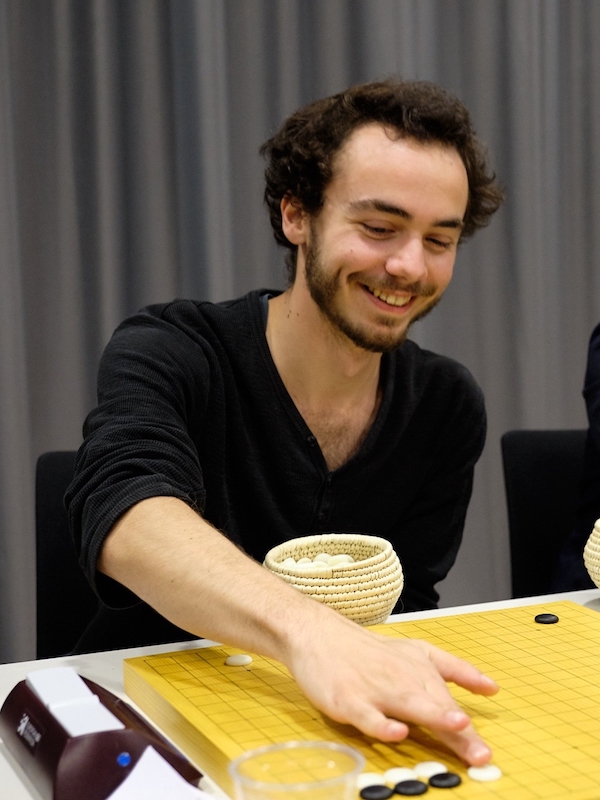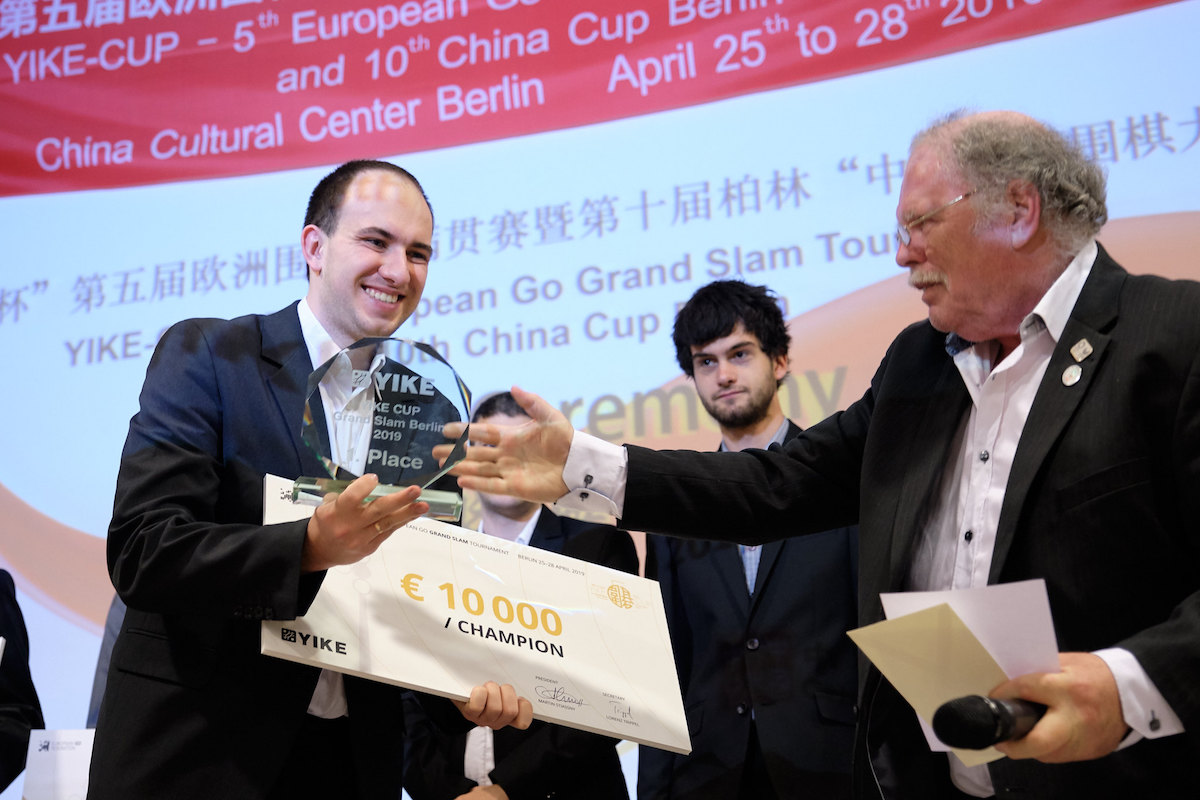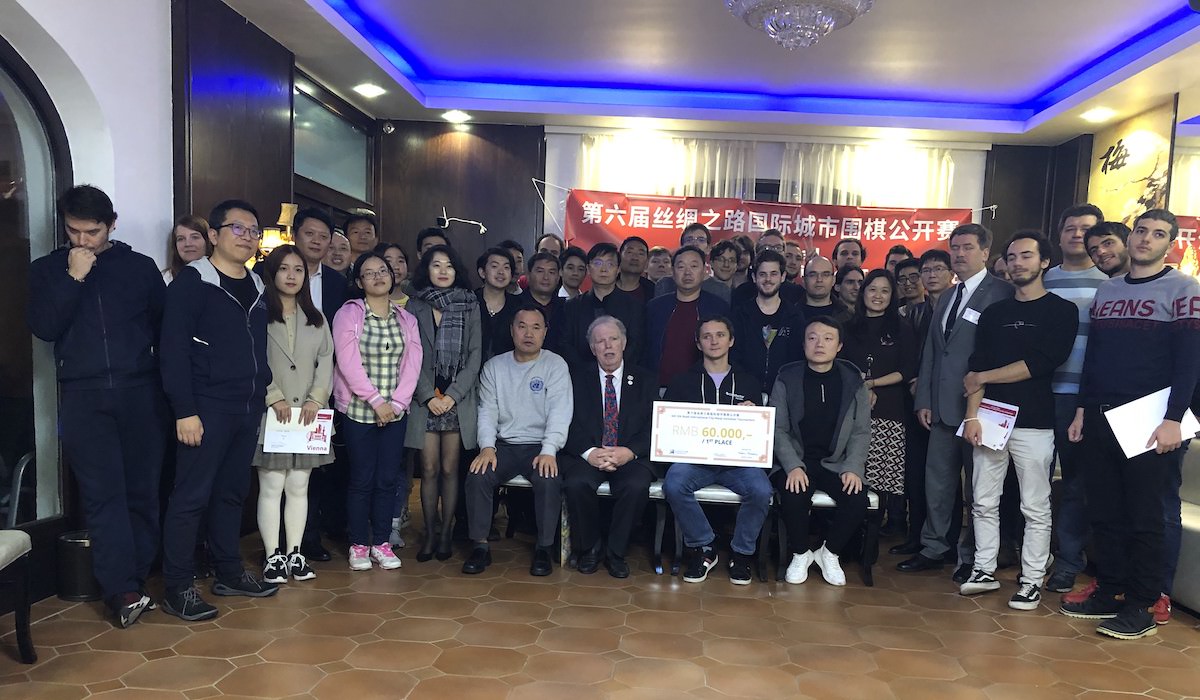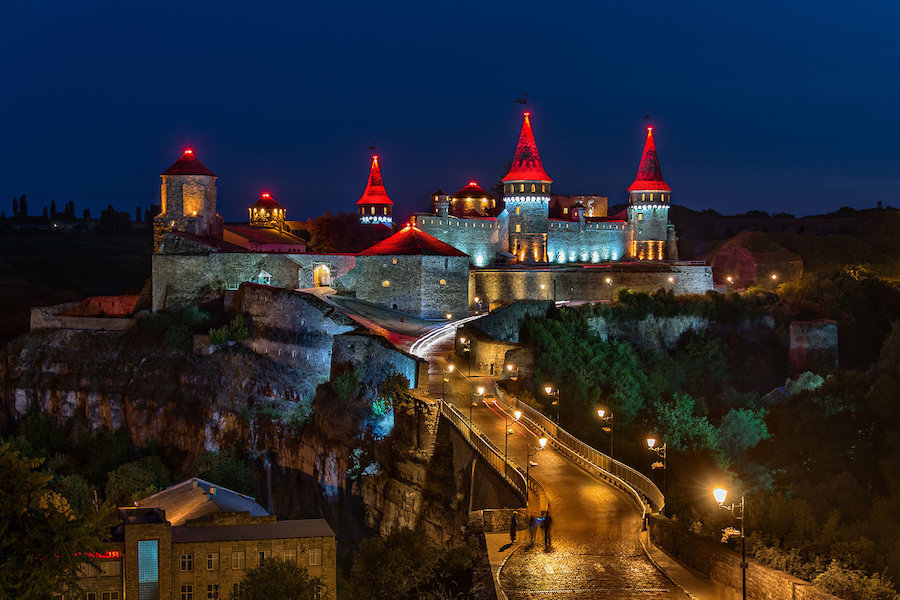
Catalin Taranu 5p
One of the new things for European go this year was the SEYGO Tour – a series of events dedicated to the youth players only. Young players are being attracted by nice prizes and conditions, opportunities to learn, and of course a friendly atmosphere. This year there were five events organised: in Romania, Germany, Croatia, Austria, and Switzerland. Next year more are coming.
The project is led by Catalin Taranu 5p from Romania. Catalin studied go in Japan and became a professional player there. After coming back to Europe, he was at the top of European go for a long time. Nowadays he is very actively involved in the European go scene, both as a teacher and an organiser.
You can find more information about the SEYGO Tour on the SEYGO webpage of the EGF website. In order to understand the atmosphere of the SEYGO events, I strongly recommend to watch the following videos:
I prepared several questions for Catalin. Enjoy the read!
Artem: Please explain shortly what is SEYGO Tour.
Catalin: SEYGO (Saijo European Youth Go) Tour is a chain of European events dedicated exclusively to youth. Saijo is the name of my teacher to whom I owe everything I know about go and many things about life. This initiative is meant to be part of a larger plan to improve the situation of go in Europe.
This idea would not be possible without people who believe in it. For me it was a miracle that quite a few people chose to join the project. You can think of SEYGO as a European Grand Prix. It is my hope that we will reach a point in the near future when almost every European country will host a stage of SEYGO.
Artem: How did the idea of such project come to you?
Catalin: I returned from Japan in 2004 with a declared goal to promote the game in Europe. I had no experience whatsoever, except that I had a decent strength as a go player, so it was a long learning process full of trials and errors that brought me to the current SEYGO project.
From 2004 to 2007 I held a Saijo Go Club in Bucharest and initiated a lot of workshops for beginners integrated in larger events, many of them related to Japanese culture. The continuation was five years of Japanese Ambassador’s Cup, an event that brought together about 150 players each year and stimulated other organisers in the country to do better.
Next, I brought the EYGC and WYGC to Romania. Following that, I took a break to make kids of my own, which should also count as a slight increase in the European go population.
In the recent years we are organising the International Winter Go Festival in Vatra Dornei, my home town. It has become a popular event; this year we had a total number of participants of around 300 people.
What I noticed and keeps me doing is how much the motivation of participants to such events grows. It is clearly the way to keep the community together and the snowballing effect caused by well-organised events is amazing.
As a teacher, I started without bias in 2004 but nowadays I mostly teach the youth. For the last four years I have taught at the EGF Academy some of the best youth in Europe, and getting to know in depth how talented they are and how quickly they progress was very motivating for me as well. In Romania, I have taught at more youth events than I can remember.
The trigger that generated the SEYGO idea came actually from the youth themselves. Two years ago in Vatra Dornei, during our festival, I organised an EGF Academy training camp. Since the Academy is an online training program, most of the youth didn’t know each other in person. I remember I brought them together and told them, from this moment on you are friends. I guess this is what they really wanted, as what resulted was an incredible sense of friendship, enthusiasm, and identity as part of a group.
Consequently, two months later many of the them, including new ones, organised by themselves a new training camp in Zagreb. Some of the youth traveled over a thousand kilometres to get there. They were youth from Germany, Croatia, Romania, Poland, Czechia, Russia, Spain, Belgium, Bulgaria, Hungary etc. so it was a real European feeling to have them all in the same place.
I was very impressed with it and told myself that we should do something about it and give the youth regular opportunities to meet and be go friends.
That’s how the SEYGO idea came into play.
If you think about it, we live in an era where Europe has become a kind of big country in itself, with cheap flights and no need for visa (for most countries). Some places in other European countries may be easier to reach than some places in our own country.
Internet makes it easy to communicate. We have all the necessary tools in order to start something truly international.
Artem: How did the first edition of SEYGO Tour go?
Catalin: As you can imagine, a new project like this is not easy to implement. Initially five stages were planned at the end of 2018, based on the goodwill of people who liked the idea and wanted to get involved. In the last moment Jena joined, so I thought we will have six events, but then due to the sale of EGCC in Amstelveen the projected Grand Final there had to be cancelled, so we were back to five events.
We started SEYGO in 2019 with a stage integrated in the Vatra Dornei Winter Go Festival. This was a safe bet, because the event was already established and we have a strong support from the local administration and community. The participation was amazing: we had 120 youth, out of whom 22 in the beginner tournament, but some referee confusion with the new SEYGO system generated plenty of errors and round delays, so I was not happy. Nevertheless the prize giving ceremony of the first-ever SEYGO tournament was touching, with many youth showered with prizes.
In May there was the Jena event. I thought that many youth from Germany would join and that quite a few others from Europe would like to visit the recently founded Jena Go school, but surprisingly the participation rate was very low. This points out the big aji of SEYGO: good organisation without good participation is kind of meaningless.
Then we had Zaostrog, Croatia, a truly beautiful event and an unforgettable memory for everyone who attended. With about 75 youth participants it was a success in every aspect.
I was really worried about our next two events in Vienna and Geneva/Lausanne because expected attendance of local youth was very low, but the organisers Viktor Lin and Flavien Aubelle surpassed all expectations and really did everything in their power to prepare a nice event – and nice events they were. This is the true spirit of SEYGO: do everything with passion, and then magic will happen.
I was also quite surprised that in four out of the five events we managed to keep a standard budget of 1200 euro for prizes. Considering SEYGO has no sponsor yet, the organisers’ efforts are commendable.
To conclude, I would venture to say that SEYGO 2019 exceeded my expectations. Nevertheless, the countries that supported the project with participants were Romania, Croatia and Ukraine with very few
additions from Germany, Russia, Switzerland, Belgium, and Bulgaria. This means that SEYGO is still very far from truly being a Europe-level project.
It was really nice to have a group of Chinese youth at two of our events, and I got a confirmation that next year they will come again.
I should add that thanks to the volunteer work of many people, a European Youth Yearbook is almost finished writing and will be available from January 2020 in printed form. Most of the book content is coverage of EYGC and SEYGO tour with reports, photos, commented games and so on, but there are quite a few other attractions that will make for a very pleasant read. In my opinion this was an important step forward, and this book will be a very powerful dissemination tool. The book was written with total and selfless dedication by Sinan Djepov, former European Youth Champion from Bulgaria.

Artem: Which one was the biggest of the SEYGO tournaments this year? How many players participated?
Catalin: Well, we had two events that were special because they lasted one week. The Winter Go Festival in Vatra Dornei starts with three days of SEYGO and then continues with activities dedicated to players of any age. Naturally, many youth that attended SEYGO chose to stay for the rest of the festival as well. On the other hand, Zaostrog in Croatia was a one-week event dedicated entirely to youth.
It is natural that a one-week event feels like a holiday and gives plenty of opportunities to enjoy more than just the game, and that’s why those two events can be considered the pillars of SEYGO.
Even though Vatra Dornei wins in terms of participation and prize budget, with 120 player participants and many special prizes, I would say that Zaostrog was our star event of 2019. It had about 75 youth players and flawless organisation thanks to Medak family, a lot of fun, a truly beautiful venue, quiet and safe, at the amazing Adriatic seaside.
My perception might be affected by the weather; while this year was the first one in Vatra Dornei without snow, we got a truly perfect weather in Zaostrog.
Artem: What is the plan for SEYGO Tour in year 2020?
Catalin: SEYGO will grow. I am very happy that France and Ukraine joined the tour, but we have to investigate possibilities to still do it in Germany since Jena organiser Manja Marz announced that they will take a break next year. Also, I am really keen to have a stage in UK at the London Go Center, which is quite a good location for playing Go, but expected participation is once more the big question.
We might have a really nice surprise and organise a special SEYGO event in China, but this is for the moment a nice idea that needs careful thought. Nevertheless I am really happy about the feedback
we are getting from China that we are doing the right thing with SEYGO.
The draft of a SEYGO calendar will be published soon on the webpage, and the winter events are already confirmed anyway, so youth are welcome to join the first stage in Grenoble, France during 1–2 February and the second stage in Vatra Dornei during 9–11 February. Vienna and Lausanne are going to happen again, but the dates are not yet decided.
Beside the events there is a plan to start a teacher program, but it maybe too early to implement it. We will have to reach an agreement on such things between the members of the International SEYGO team of organisers.
Artem: How do you plan to develop the project in the long-term perspective?
Catalin: There are some important directions that need careful thought and monitoring:
- solidify what we have done so far and ensure a steady growth in the quality and number of events
- keep up and improve international communication, involving organisers, teachers, leaders, and youth
- start a teacher program in three phases: support and motivate existing teachers, recruit new teachers with reachable means, and a mass teacher program through large-scale projects
- start a SEYGO referees training program and a referee grade system
- make sure the European Youth Yearbook gets a yearly release
- find partners and sponsors for the project
- start an advertising campaign
The ultimate goal is to increase drastically the youth go playing population in Europe. Currently Europe surely has more than 1,000 youth playing Go, but based on tournament participation it is hard to say that more than 200–300 are active. The first step towards a million players is to achieve 1,000 active players. Then 5,000 and so on. I strongly believe that once a certain threshold is reached, a snowballing effect of large proportions will change everything.
Artem: What does the project need for perfect development?
Catalin: A very short analysis of the current situation tells us that we have two big sources of aji in our shape.
At some point I tried to start a series of articles on current youth situation in European countries. You would be surprised how many countries answered that they have nothing to say about youth development.
Another aspect is teachers. Most of the existing European go teachers are like isolated islands in an archipelago where sailing was not yet invented. They do their work wonderfully at a local level but otherwise are not interested or motivated to send the youth to other events. There was an attempt to create an European teacher channel on some social network but as far as I can tell, it is not really working.
So, the work to be done here and the requirements for a perfect SEYGO would be to get the organisations involved and aware that youth activities are crucial, and teachers understanding that for
most youth the primary motivation is not playing go but socialising and having fun together. Events, the bigger the better, are just perfect to increase youth motivation. Since young people are much
better than adults at communicating, they actually share their story so a motivated youth can generate many more, making the teacher’s job easier and also more motivating.
As you see, motivation is a key word. Another one is communication. I think teachers really need to communicate often and get involved more in the larger community activities. A teacher support program is one of my key ideas, but it may take years to get the existing teachers into a true network. I would define a SEYGO teacher concept: a person who is actively promoting the events to youth and their parents, encouraging them to attend. In exchange, such a teacher would have a lot to benefit as well.
Other than that, the project needs human resources. All that was done so far was volunteer work on our part, but as the project grows the amount of work grows as well, so without new people to step in and help I guess a burn out moment is unavoidable at some point.
Finally, despite my best efforts to design SEYGO as a self-developing entity, some things cannot be achieved without sponsors. Other things can be achieved at a much slower pace.
The yearbook is a good example: a sponsor is needed to print the first books. After that the book could be made again and printed with money from sales from the previous year. This also means
that the community can be the biggest sponsor, as buying the book allows us to do it again in the future.
I guess the ideal situation is to either succeed with an EU project or to get a high-profile sponsor. If expenses for:
- mobility costs for the volunteer international team,
- advertising materials including presentation videos and everything else required by a coherent advertising campaign,
- prize fund, especially the special yearly awards based on overall participation,
- a yearbook,
- special awards and stimulants for best youth , best teachers and best organisers,
- website management and maintenance,
- few deeply involved people getting salary so they can dedicate full time to the project, and
- financial management costs (accounting)
could be covered, then SEYGO would skyrocket.
Report by Artem













